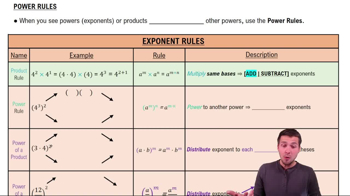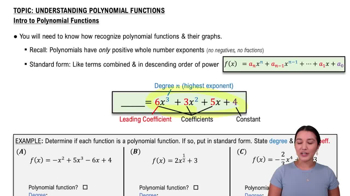Table of contents
- 0. Functions7h 52m
- Introduction to Functions16m
- Piecewise Functions10m
- Properties of Functions9m
- Common Functions1h 8m
- Transformations5m
- Combining Functions27m
- Exponent rules32m
- Exponential Functions28m
- Logarithmic Functions24m
- Properties of Logarithms34m
- Exponential & Logarithmic Equations35m
- Introduction to Trigonometric Functions38m
- Graphs of Trigonometric Functions44m
- Trigonometric Identities47m
- Inverse Trigonometric Functions48m
- 1. Limits and Continuity2h 2m
- 2. Intro to Derivatives1h 33m
- 3. Techniques of Differentiation3h 18m
- 4. Applications of Derivatives2h 38m
- 5. Graphical Applications of Derivatives6h 2m
- 6. Derivatives of Inverse, Exponential, & Logarithmic Functions2h 37m
- 7. Antiderivatives & Indefinite Integrals1h 26m
1. Limits and Continuity
Finding Limits Algebraically
Problem 37
Textbook Question
Find the following limits or state that they do not exist. Assume a, b , c, and k are fixed real numbers.
lim x→b (x − b)^50 − x + b / x − b
 Verified step by step guidance
Verified step by step guidance1
Identify the form of the limit: As \( x \to b \), the expression \((x - b)^{50} - x + b\) becomes \(0 - b + b = 0\), and the denominator \(x - b\) also becomes 0, indicating an indeterminate form \(\frac{0}{0}\).
Apply L'Hôpital's Rule: Since the limit is in the indeterminate form \(\frac{0}{0}\), we can apply L'Hôpital's Rule, which involves differentiating the numerator and the denominator separately.
Differentiate the numerator: The derivative of \((x - b)^{50} - x + b\) with respect to \(x\) is \(50(x - b)^{49} - 1\).
Differentiate the denominator: The derivative of \(x - b\) with respect to \(x\) is 1.
Evaluate the new limit: Substitute \(x = b\) into the expression \(\frac{50(x - b)^{49} - 1}{1}\) to find the limit.
Recommended similar problem, with video answer:
 Verified Solution
Verified SolutionThis video solution was recommended by our tutors as helpful for the problem above
Video duration:
3mPlay a video:
Was this helpful?
Key Concepts
Here are the essential concepts you must grasp in order to answer the question correctly.
Limits
A limit is a fundamental concept in calculus that describes the behavior of a function as its input approaches a certain value. It helps in understanding how functions behave near points of interest, including points where they may not be defined. Evaluating limits is crucial for determining continuity, derivatives, and integrals.
Recommended video:

One-Sided Limits
L'Hôpital's Rule
L'Hôpital's Rule is a method used to evaluate limits that result in indeterminate forms, such as 0/0 or ∞/∞. It states that if the limit of f(x)/g(x) as x approaches a value results in an indeterminate form, the limit can be found by taking the derivative of the numerator and the derivative of the denominator separately. This rule simplifies the process of finding limits in complex cases.
Recommended video:
Guided course

Power Rules
Polynomial Functions
Polynomial functions are expressions that involve variables raised to whole number powers, combined using addition, subtraction, and multiplication. In the context of limits, polynomial functions are continuous everywhere, which means their limits can often be evaluated by direct substitution. Understanding the behavior of polynomials as they approach specific values is essential for solving limit problems.
Recommended video:

Introduction to Polynomial Functions

 5:21m
5:21mWatch next
Master Finding Limits by Direct Substitution with a bite sized video explanation from Callie
Start learningRelated Videos
Related Practice







